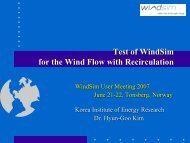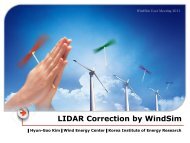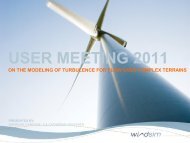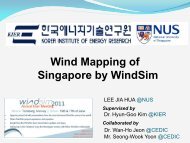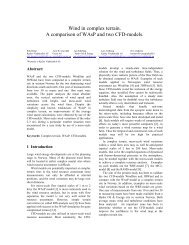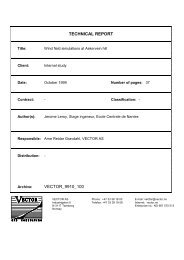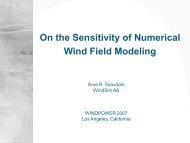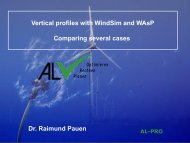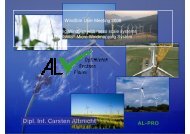wind energy resource evaluation in a site of central italy ... - WindSim
wind energy resource evaluation in a site of central italy ... - WindSim
wind energy resource evaluation in a site of central italy ... - WindSim
You also want an ePaper? Increase the reach of your titles
YUMPU automatically turns print PDFs into web optimized ePapers that Google loves.
6.7 Cross Check<strong>in</strong>g <strong>of</strong> <strong>w<strong>in</strong>d</strong> dataIn the follow<strong>in</strong>g paragraphs the cross check<strong>in</strong>g <strong>of</strong> the experimental data, asexpla<strong>in</strong>ed <strong>in</strong> chapter 1, is presented. The W<strong>in</strong>dSim feature, called transferredclimatology object, was used. As previously described when multiple measurementmasts are available <strong>in</strong> one <strong>site</strong>, it is possible to predict by CFD calculation the <strong>w<strong>in</strong>d</strong><strong>resource</strong>s <strong>in</strong> one measurement station us<strong>in</strong>g data available <strong>in</strong> the othermeasurement station. In other words, it’s possible to transfer <strong>w<strong>in</strong>d</strong> data from theorig<strong>in</strong>al position to the other tak<strong>in</strong>g <strong>in</strong>to account the different orographic androughness effectsThe cross check<strong>in</strong>g has been studied us<strong>in</strong>g two different procedures, us<strong>in</strong>g as scal<strong>in</strong>gvariable the mean <strong>w<strong>in</strong>d</strong> velocity per sector and the speed-up values, respectively.In the first case the experimental mean velocity values have been extracted by thetime history, while all the CFD values have been calculated us<strong>in</strong>g the sector<strong>in</strong>terpolation function [4] <strong>of</strong> W<strong>in</strong>dSim.In the second case, relative to the speed-up calculation, two methods have beenused, one consider<strong>in</strong>g the sector <strong>in</strong>terpolation and the other one without thisoption. Concern<strong>in</strong>g the experimental speed-up, this value was calculated directlyfrom experimental dataset, by a ratio between the mean velocity <strong>in</strong> the referencemast and the mean velocity <strong>in</strong> the new position.Sector <strong>in</strong>terpolationThe sector <strong>in</strong>terpolation function is a correction function <strong>of</strong> W<strong>in</strong>dSim, needed whenthe CFD results must be weighted aga<strong>in</strong>st one experimental data-set, <strong>in</strong> order todeterm<strong>in</strong>e the horizontal <strong>w<strong>in</strong>d</strong> speed map.When the <strong>w<strong>in</strong>d</strong> direction boundary condition is given, it is applied at the boundaries<strong>of</strong> the model, by describ<strong>in</strong>g a geostrophic <strong>w<strong>in</strong>d</strong>. Nevertheless the <strong>w<strong>in</strong>d</strong> evaluated <strong>in</strong>the <strong>in</strong>ternal zone can be deviated by orographic effects, especially close to theground. For <strong>in</strong>stance, if two simulations are run for sectors 0° and 30° as boundaryconditions, <strong>in</strong> the center <strong>of</strong> the doma<strong>in</strong> the <strong>w<strong>in</strong>d</strong> direction could be, for <strong>in</strong>stance, 2°and 35° respectively. In this case there will be a mismatch between the directions <strong>of</strong>108




